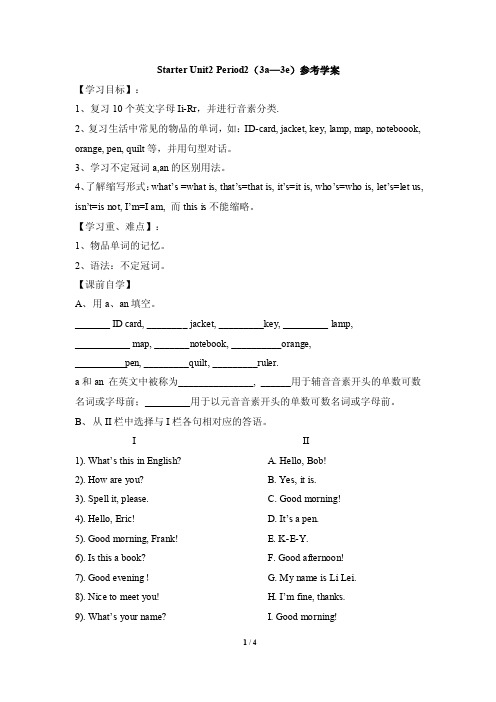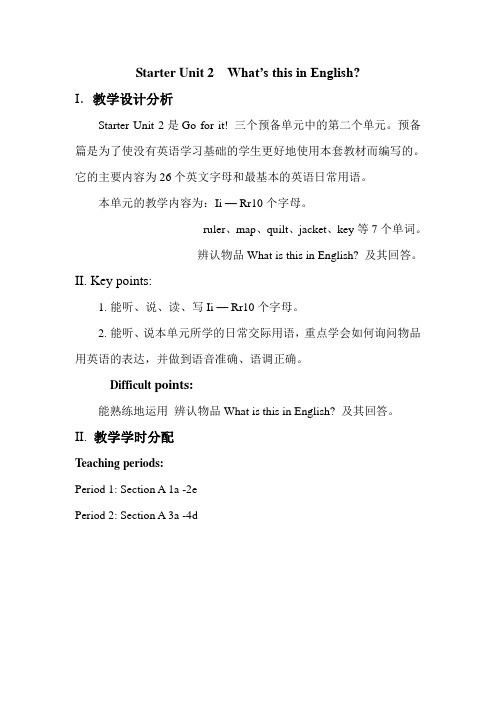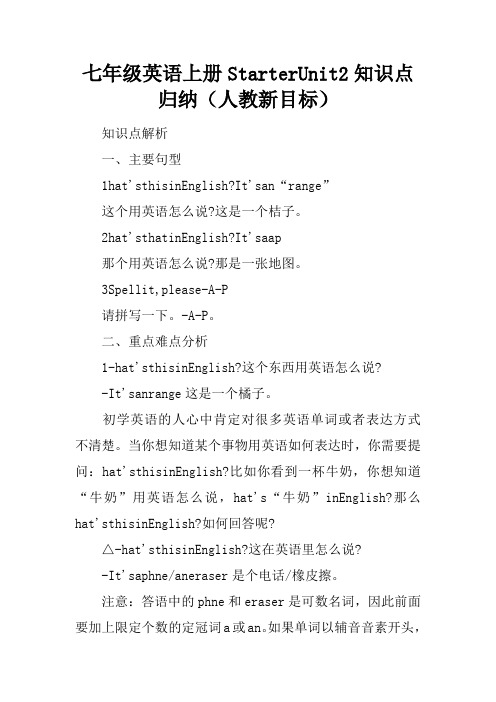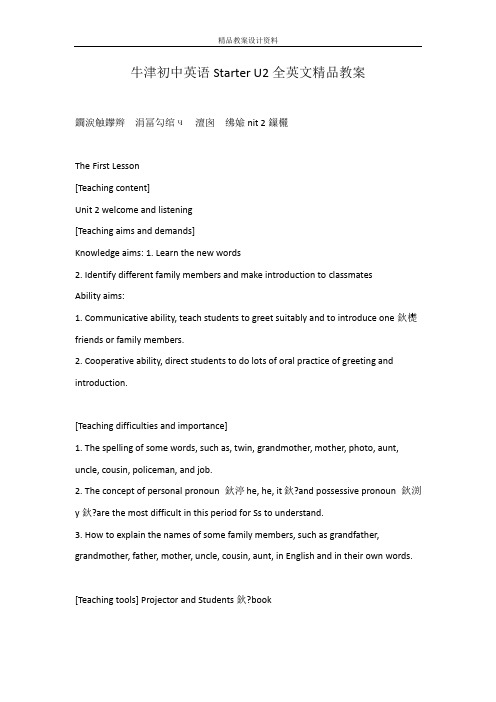Starter U2 Period 2
- 格式:ppt
- 大小:1.97 MB
- 文档页数:38

Starter Module2 Unit1教案Unit 1 Open your book.课型:Listening and speaking课时:45 minute s课前预测:They have learnt some everyday English, In this Unit, they continue to learn some more about it.教学方法:Interactive approach板书设计:Key words and sentences about everyday English in PPT.教学目标:1. Master the key words and expressions in Unit 1.2.Learn to use the key sentences to greet each other..3.Cultivate their ability of creation.教学重难点:1.Key words and expressions:S it/ stand/ open/ close/ up/ down etc.2.Key sentences:Open your book.Close your book.Stand up.E tc.3.How to use what they have learnt to greet each other.4.How to write the key sentences regularly.教学准备:PPT/pictures on the Internet/ videotape.教学过程:Step 1.Warming up:1.Revise the letters in Module 1.2.Revise the words and key sentences they have learnt in Module 1. step2.Introduction1.learn new words and read them together,especially, pay attention to their pronunciation.2.Read all the new words freely, give them some help and ask some of them to read them in class.step3.Listen and read.Listen to Part 1, read after it. T hen read it in pairs.step4.Listen and repeat:1.Listen to the tape in Part 2, repeat.2.Read Part 2 with the help of their teacher freely.3.Do as the teacher’s order.step5.Matchplete Part 4 by themselves.2.Read the answers together to check them.step6.TranslateShow the questions quikly, ask them to translate them orally in class. step7.Write.1.Listen to the tape and write their answers in their books.2.Show the answers to check their answers,give more encouragement. step8.Work in pairs.1.Work in pairs to complete Part 6.2.Ask some of them to act in class.step9.Everyday English1.Show the questions and ask them how to answer.2.Read Everyday English in groups..step10.ExercisesDo some exercises in class to consolidate what they have learnt in this lesson. E ncouragement should be given.S tep11. Homework1.Copy the key sentences correctly in their exercise books.2.Read Unit 1 smoothly.3.Try to remember the spelling of the new words and expressions.4.Learn to sing the song hello, how are you?Starter Module2 Unit2教案Unit 1 What’s your number?课型:Listening and speaking课时:45 minute s课前预测:They have learnt some everyday English, In this Unit, they continue to learn some more about it.教学方法:Interactive approach板书设计:Key words and sentences about everyday English in PPT.教学目标:1. Master the key words and expressions in Unit 1.2.Learn to use the key sentences to greet each other..3.Cultivate their ability of creation.教学重难点:1.Key words and expressions:new/ student/ here/ in/ one/ two/ three etc.2.Key sentences:What’s your telephone number?Are you a new student here?What class are you in?E tc.3.How to use what they have learnt to ask and answer each other.4.How to write the key sentences regularly.教学准备:PPT/pictures on the Internet/ videotape.教学过程:Step 1.Warming up:1.Revise the words in Unit 1 by doing some exercises.2.Ask some questions in Unit 1 freely.step2.Introduction1.learn the numbers 1--10 and read them together,especially, pay attention to their pronunciation.2.Have a quick test,give them some help and ask some of them to read them in class.3.Learn some other new words and read them together, encouragement should be given.step3.Listen and chant.1.Listen to the tape in Part3 at first, then listen again to learn to chant.2.Chant each other, ask some of them to act it in class.step4.Listen and readt:1.Listen to the tape in Part 1, repeat.2.Read Part 1 with the help of their teacher freely.3.Read the dialogue in pairs.4.Like this, Ask and answer Lala’s information.,then ask their classmates. step5.Listen and read1.Read Part 4 by themselves, find the telephone numbers and fill in the blanks.2.Read the answers together to check them.3.Listen to the tape in Part 4 and read after it, read it for some more times with the help of the teacher freely.4.Read it in groups ,then in pairs in class.step6.Listen and pointListen to the tape carefully,check the answers one by one.step7.Listen and write.1.Listen to the tape and write their answers in their books to finishPart 6.2.Show the answers to check their answers,give more encouragement.3.Listen to the tape in Part 7, write the numbers. Check answers andread them together.step8.Work in pairs.1.Work in pairs : what’s your telephone/QQ number?2.Ask some of them freely in class.step9.Listen and write1.Listen to the tape in Part 8, fill in the table on their own, checkanswers.2.Ask them to ask and answer in pairs according to the table in Part8.3.Ask and answer freely to finish Part 9.Step 10. Complete and find:A: ________ you a new student here?B: Yes, I _______.A: What class are you in?B: I’m in Class Five , Mr Liu’s class.A: What class ________Li Minghao in?B: He is in Class Six, Miss Liang’s class.step11.ExercisesDo some exercises in class to consolidate what they have learnt in this lesson. E ncouragement should be given.S tep12. Homework1.Make a survey and write their friends’ telephone number.2.Read Unit 2 smoothly, including the new words, try to have a dictation.3.Continue to learn the 48 phonetic symbol s.Starter Module2 Unit3教案Unit 1 What’s your number?课型:Listening and speaking课时:45 minute s课前预测:They have learnt some everyday English, In this Unit, they continue to learn some more about it.教学方法:Interactive approach板书设计:Key words and sentences about everyday English in PPT.教学目标:1. Master the key words and expressions in Unit2.2.Learn to use the key sentences to ask and answer each other..3.Cultivate their ability of creation.教学重难点:1.Key words and expressions:H ow old, boy, girl, desk, chair, bag, thirteen, fifteen etc.2.Key sentences:How old are you?I’m twelve.H ow many girls/ boys are there?E tc.3.How to use what they have learnt to ask and answer each other.4.How to write the key sentences regularly.教学准备:PPT/pictures on the Internet/ videotape.教学过程:Step 1.Warming up:Revise the numbers in Unit 2 by a quick test.step2.Introduction1.learn the new numbers 11--20 and read them together,especially, pay attention to their pronunciation.2.Have a quick test,give them some help and ask some of them to read them in class.3.Match the numbers in Part 3, check answers.4.Tell them how to write the numbers from 21 to 29.5. Learn some other new words and read them together, then freely. G ive them some help.step3.Listen and Point.Listen to the tape in Part4 at first,check answers, then listen again to repeat.step4.Listen and write:1.Listen to the tape in Part 5,write the answers at the same time.2.Check answers and read it one by one.4.Learn about some more, like: plus/minus/multiply/dividestep5.Listen and write1.Listen to the tape in part 6, write the numbers in their books.2. Check answer each other ,read them loud in class.step6.Listen and MatchListen to the tape in Part 7 carefully,check the answers .step7.Listen and read.1.Listen to the tape in Part 1and repeat.2.Act the dialogue in pairs.step8.Work in pairs.1.Work in pairs : How many boys/girls are there?2.Ask some of them freely in class.step9.Inclusion.Sum up the key points and ask more questions freely in class.Step 10. W ords and expressions in Module 2:Listen to the tape and repeat after it.step11.ExercisesDo some exercises in class to consolidate what they have learnt in this lesson. E ncouragement should be given.S tep12. Homework1.Try to remember the spelling of words in Unit 2 and have a dictation.2.Read Unit 2 and try to recite it.3.Copy the numbers1-20 in their exercise books.。


Starter Unit2 Period2(3a—3e)参考学案【学习目标】:1、复习10个英文字母Ii-Rr,并进行音素分类.2、复习生活中常见的物品的单词,如:ID-card, jacket, key, lamp, map, noteboook, orange, pen, quilt等,并用句型对话。
3、学习不定冠词a,an的区别用法。
4、了解缩写形式:what’s =what is, that’s=that is, it’s=it is, who’s=who is, let’s=let us, isn’t=is not, I’m=I am, 而this is不能缩略。
【学习重、难点】:1、物品单词的记忆。
2、语法:不定冠词。
【课前自学】A、用a、an填空。
_______ ID card, ________ jacket, _________key, _________ lamp,___________ map, _______notebook, __________orange,__________pen, _________quilt, _________ruler.a和an 在英文中被称为_______________, ______用于辅音音素开头的单数可数名词或字母前;_________用于以元音音素开头的单数可数名词或字母前。
B、从II栏中选择与I栏各句相对应的答语。
I II1). What’s this in English? A. Hello, Bob!2). How are you? B. Yes, it is.3). Spell it, please. C. Good morning!4). Hello, Eric! D. It’s a pen.5). Good morning, Frank! E. K-E-Y.6). Is this a book? F. Good afternoon!7). Good evening!G. My name is Li Lei.8). Nice to meet you! H. I’m fine, thanks.9). What’s your name? I. Good morning!10). Good afternoon! J. Nice to meet you, too!3、将下列句子组成一段对话。

I.教学设计分析Starter Unit 2是Go for it! 三个预备单元中的第二个单元。
预备篇是为了使没有英语学习基础的学生更好地使用本套教材而编写的。
它的主要内容为26个英文字母和最基本的英语日常用语。
本单元的教学内容为:Ii — Rr10个字母。
ruler、map、quilt、jacket、key等7个单词。
辨认物品What is this in English? 及其回答。
II. Key points:1.能听、说、读、写Ii — Rr10个字母。
2.能听、说本单元所学的日常交际用语,重点学会如何询问物品用英语的表达,并做到语音准确、语调正确。
Difficult points:能熟练地运用辨认物品What is this in English? 及其回答。
II. 教学学时分配Teaching periods:Period 1: Section A 1a -2ePeriod 2: Section A 3a -4dThe First Period1a-2eI. Teaching aims1. Learn to read and write letters Ii — Rr.2. Master the sentence: What’s this in English?3. Be able to ask things in English.4. Learn the meaning of some abbreviations.5. Develop students’ interest in English.6. Educate students to be polite.II. Key points1. Learn to read and write letters Ii — Rr.2. Be able to use the sentence: What’s this in English?Difficult pointBe able to use the sentence: What’s this in English?III. Teaching aidsMultimedia/A tape recorder/A blackboard/ A rulerIV. Teaching proceduresStep 1 Warm-up1. Greetings.2. Warming upT: Good morning/afternoon/evening!S: Good morning/afternoon/evening!T: How are you?S: I’m fine, thanks.3. Sing the alphabet songStep 2 Presentation1. A Guessing gameTeachers show a part of a letter and ask,―What’s this?‖Get the students to answer the questions like this―think it’s A/B.‖Then show the whole of the letter to let the students check whether they’re right or wrong.2. Teach the letters Ii—Rr, using: What’s this in English? It’s I / J/---1) Listen, look and saya. Section A – 2ab.Section A – 2c , listen to the tape and write the number of the letters in theboxes according to the order in which you hear them. Play the recording twice and check the answer.2) A Guessing gameTeacher shows a part of a letter and asks : ―What’s this?‖ Get the students toanswer the questions like this: ― I think it’s A / B.‖ Then show the whole ofthe letter to let the students check whether they’re right or wrong.3) Look and learn1. Section A-32. Teacher shows more special letters.3. Ss try to think of other special letters.Step 3 Practice1. Ask students to write letters Ii — Rr.after the models. At the same time, ask one boy and one girl to write on the blackboard.2. Show the pictures in 2e on the blackboard.T: Do you know the meaning of the letters below each picture?T: Do you know any other abbreviations? Please list them out.Step 4 Consolidation1. Listen and repeat1.Find friends. Get the students work in groups of four, and find the friends(the same vowels) for A, E, I, O, F.2.Section B –4, listen and repeat.3.ExercisesHave a chant.Step 5 SummaryIn this period, we’ve learned how to use-- What’s this in English? It’s . And we’ve also learned how to read and write letters Ii — Rr, and some abbreviations.Step 6 Homework1. Copy letters Ii — Rr five times.2. Practice the conversation in the picture, and try to recite it.3. Preview the next period.V. Blackboard designTeaching reflection:The Second PeriodSection A(3a-4d)I. Teaching aims1. Master the new words:Spell, please,2. Master the sentences:What’s this in English?It’s ...Spell it, please. M-A-P3. Learn the usage of a/an4. Train students to be polite and warm.II. Key points1. Master the new words and expressions.Difficult pointBe able to use the simple expressions.III. Teaching aidsMultimedia/A tape recorder/A blackboardIV. Teaching proceduresStep 1 Warm-up1. Greetings.2. Sing a song : What’s th is?3. (a). Game: find out the lettersTeacher shows the letters very quicklyget the students to call out the lettersthey see.(b) Group workStudents prepare in groups four, draw some pictures or diagram, getthe others to guess what letters they are.Step 2 Presentation1. Letters challenge.Teacher shows the letters very quickly get the students to call out the letters they see.2. Listen, look and saya. Section A – 1ab. Section B – 1aStep 3 Practice1. A Guessing game.What’s the word?1) Teacher thinks of a word that the Ss know. Draw a dash on the Bb for each letter. Get a student to suggest a letter. Then another student and another letter untilthey get all the letters of the words.2. Show the picture which match the word and ask: What’s this in English?Ss answer: ― It’s a / an …‖Spell it, please. ----3. Get individuals to give their own words.Step 4 Consolidation1. Group workStudents work in groups, draw pictures of their rooms and talk about the pictures using ―What’s this in English? It’s a/an…‖Teacher is ready to offer his / her help to those students who are in need of it.2.ReportAsk some demonstration groups to show their pictures before the whole class. They may do like this: This is my room. What’s this in English? It’s a/an…3. Listening1.Section A 4a2. Section A 4bStep 5 SummaryIn this period, we’ve learned key sentences. And we’ve also consolidated the names of the children.Step 6 Homework1. Practice the conversation and recite it.2. Preview the next unit.V. Blackboard designTeaching reflection:。

七年级英语上册StarterUnit2知识点归纳(人教新目标)知识点解析一、主要句型1hat'sthisinEnglish?It'san“range”这个用英语怎么说?这是一个桔子。
2hat'sthatinEnglish?It'saap那个用英语怎么说?那是一张地图。
3Spellit,please-A-P请拼写一下。
-A-P。
二、重点难点分析1-hat'sthisinEnglish?这个东西用英语怎么说?-It'sanrange这是一个橘子。
初学英语的人心中肯定对很多英语单词或者表达方式不清楚。
当你想知道某个事物用英语如何表达时,你需要提问:hat'sthisinEnglish?比如你看到一杯牛奶,你想知道“牛奶”用英语怎么说,hat's“牛奶”inEnglish?那么hat'sthisinEnglish?如何回答呢?△-hat'sthisinEnglish?这在英语里怎么说?-It'saphne/aneraser是个电话/橡皮擦。
注意:答语中的phne和eraser是可数名词,因此前面要加上限定个数的定冠词a或an。
如果单词以辅音音素开头,就用不定冠词a。
如果单词以元音音素开头,就用定冠词an。
例如:ab一本书,aneraser一块橡皮。
inEnglish表示“用英语表达”,inhinese则表示“用汉语表达”。
hat's=hatis,hat用来询问某物是“什么”,is是be 动词一般现在时的第三人称单数形式。
this“这、这个”,是指示代词,而that表示“那、那个”,it“它”,是指物的人称代词。
anrange“一个橘子”。
an是不定冠词。
当单数可数名词以元音开头,则前面可以用不定冠词an;如果单数可数名词以辅音开头,则前面可使用不定冠词a。
如:aap一幅地图;aneraser一块橡皮擦。
不可数名词前一般不用不定冠词。

牛津初中英语Starter U2全英文精品教案чnit 2The First Lesson[Teaching content]Unit 2 welcome and listening[Teaching aims and demands]Knowledge aims: 1. Learn the new words2. Identify different family members and make introduction to classmatesAbility aims:1. Communicative ability, teach students to greet suitably and to introduce one鈥檚friends or family members.2. Cooperative ability, direct students to do lots of oral practice of greeting and introduction.[Teaching difficulties and importance]1. The spelling of some words, such as, twin, grandmother, mother, photo, aunt, uncle, cousin, policeman, and job.2. The concept of personal pronoun 鈥渟he, he, it鈥?and possessive pronoun 鈥渕y鈥?are the most difficult in this period for Ss to understand.3. How to explain the names of some family members, such as grandfather, grandmother, father, mother, uncle, cousin, aunt, in English and in their own words.[Teaching tools] Projector and Students鈥?book[Teaching procedure]Pre-teaching1.Teach the new wordsAsk the students to read all of the new words by themselves before teaching, so that the teacher can correct their mistakes in phonetics.2. Ask all students to read all of the new words before learning the text.3. As for the spelling of the new words, there are some in which students always have difficulty, such as, twin, grandmother, mother, photo, uncle, cousin, policeman, and job, , especially cousin, about which even after a few units鈥?learning, some Ss will forget all. It is both hard in pronouncing and spelling. So the dictation of 鈥渃ousin鈥?is needed for several times, and the teacher has to use 鈥渃ousin鈥?often as well, so that Ss can remember it through use.Step 1 Presentation1. Have a casual chat with students, including these questions:Do you have a family? Is your family a big family or a small one?How many people are there in your family ? Who are they?So that the teacher can lead to the subject of this unit.2. Teach students t the similar word: my family = my family membersStep 2 Welcome to the unit1. Have a small talk with Ss, with common and easy greetings ways which they learned in Unit2. Ask them to read the dialogues on P12 twice to grasp the meaning of it.3. Ask some question about the dialogue, for example, Who is Peter ? Who is Lily? Who is Nick? Who is Sally? Who is Mimi? Who is Spotty?Whose pet is Mimi? Whose pet is Spotty?4. Guide students to replace all of the names in the dialogues with those of their classmates and use some similar words and similar sentences to make another dialogue of their own.For example, Good morning = Morning, She is my cat = It is my cat.5. Pair work and give students chances to show their own dialogues.Step 3 Listening1. Pre-listening.Ask students to read the four words of Part A by themselves just once. And then make them explain 鈥済randfather, grandmother, father, mother, uncle, aunt, cousin鈥?in English and in their own words. For example,Grandfather is the father of my mum or my dad.There is a man, I鈥檓his son. Who is he?Explain grandmother and mother in the same way.2. Make Ss recall the similar words of the four words.For example, grandfather = grandpa, grandmother = grandma, father = daddy, dad, mother = mummy, mum, grandfather and grandmother = grandparents, momSo that they can understand the words well and at the same time learn how to use English.2. Do the exercises of Part B.3. Post- listening. Direct students to make sentences with the four words in Part A as they like, one word two sentences.Step 4 Do workbook.Step 5 HomeworkThe Second Lesson[Teaching content]Unit 2 Speaking, The alphabet and Reading[Teaching aims and demands]Knowledge aims: 1. Review the new words.2. Identify different family members and make introductionAbility aims:1. Communicative ability, teach students to greet suitably and to introduce one鈥檚friends or family members.2. Cooperative ability, direct students to do lots of oral practice of greeting and introduction.[Teaching difficulties and importance]1. The spelling of some words, such as, photo, aunt, uncle, cousin, policeman, and job.2. The spelling and meaning of some phrases like a photo of my family.3. The greatest difficulty is the difference between the two sentences: 鈥渨ho is he/ she?鈥?and 鈥淲hat is he/she?鈥?[Teaching tools] Photos of students鈥?families, Projector, Workbook and Students 鈥?book[Teaching Procedure]Step 1. Revision1. Do some revision work. Review new words of both spelling and their sounds.Step 2 Speaking1. Ask the students read the dialogues in this part, and correct their mistakes in phonetics.2. Direct them to play the role in order to be familiar with the structure of the dialogue.3. Guide students to replace all of the names in the dialogues with the names of their classmates and use some similar words and similar sentences to make another dialogue of their own.For example, a photo of my family= my family鈥檚photo,4. Guide students to add two more sentences to the small dialogue so as to make it longer and better: after 鈥淲ho is she鈥? add鈥?What is her name?鈥?and after 鈥?Who is he鈥? add 鈥?What is his name?鈥?5. Pair work and give students chances to show their dialogues.Direct Ss to ask each other about their family photos, using sentences structures like 鈥淚s this鈥??鈥?鈥淵es/ No鈥?鈥淲ho is she/ he?鈥?鈥淪he/He is my...鈥濃€淲hat is her / his name?鈥?鈥淲hat is she/he?鈥?and 鈥淪he/He is a鈥︹€?, etc. And Ss take the opportunity to introduce their family members, such as grangfather, grandmother, father, mother, sister, brother, etc.6. Post- speaking work. There are four pictures at the bottom of this page. Instruct students to make a sentence of each picture, according to the what is shown in the pictures, of which the four subjects have already been given. This exercise can review the present progressive tense.Step 3 Reading1. Pre- reading work. There are already four jobs in this part: a doctor, a teacher, a policeman, and a nurse. Ask students to find more jobs, and write their names on this page, like: cook, engineer, scientist, businessman, driver, cleaner, worker, farmer,etc.2. Ask students to read the dialogue in this part by themselves twice.3. Guide students to use some similar words, similar sentences and names of other jobs to replace the dialogue, making another dialogue of their own.For example, Who is this man= Who is this? What鈥檚he= What does he do? What鈥檚she= What is her job? Who is that woman= Who is that?5. Pair work and a show time, so that they can use the sentence structures 鈥渨ho is he/ she?What is he/she?鈥?freely and correctly.Step 4 The alphabet1. Teach students the sounds of Letters O -- Z, the correct order of them, and their writing methods.2. According to the pictures, direct students to learn some words beginning with these letters and learn their phonetic symbols ( From 鈥淥鈥?to 鈥淶鈥?.3. Guide students to know the meanings of the abbreviations. Tell them to pay attention to whether capital letters are needed.For example, VIP, CCTV, ABC, IQ, PRC, RMB4. Guide students to find more abbreviations, and ask some students to show them on the blackboard.Step 5 Task1. Ask students to read the dialogue in this part by themselves twice.2. Guide students to use some similar words, similar sentences and names of other jobs to replace the dialogue, making another dialogue of their own. Furthermore, the similar sentences include 鈥?She is a nurse. = She works as a nurse.鈥?and 鈥淪he is a teacher= She does a teacher鈥檚job.鈥?3. Rewrite the dialogue of Task, using some similar words, similar sentences and names of other jobs, so students can get another chance to use the sentence structures 鈥渨ho is he/ she? What is he/she?鈥?Step 6 Summary, and do workbook.Step 7 HomeworkRewrite the dialogue of Reading part, using some similar words, similar sentences and names of other jobs, so that students can use the sentence structures 鈥渨ho is he/ she? What is he/she?鈥?freely and correctly.。
人教版七年级上册英语Starter Unit2 Period1西机学校杨媛丽Teaching and Learning Goals:In our life ,we must touch some things. eg: pen,ruler,map,etc.This class we will learn some things we can use in our life .Say it in English .and we will try our best to remember them .So this class we will learn the words in starter unit 2 and try to use them .Teaching and learning stepsStep 1Learn to read the words bying listening firstIn our countryside, Students in Grade 7 have poor English .they can’t write the let ters right ,and they can’t say the letters from Aa to Zz. So first they must try to listen to the tape ,then read after the tape,try to remember them according to the picture . Sometimes teacher can lead them to read.I, listen and read .1, put some picture of the words and ask students to guess what it is.2, Play the tape ,let students listen and try to repeat .3, Let students read by themselves , sometimes teacher can lead to read.4, Students read the words to his\her deskmate, and then read in group. Ask the other students to correct for them .Step 2 :Learn to remember words on …一. Remember the words by looking at pictures.In this unit, some words can learn by looking at the picture.this can make students have more interests in English . The following words can do like this .map cup ruler pen orange jacket key quiltWe can put the picture on TV, let students learn the words looking at them .0range ruler pen jacketquilt key map cupThe other wordsII. Remember the words by act the dialogue.如,what , is ,this , in ,English , it ,a ,an, spell ,pleaseBy acting the dialogue;A: W hat’s this in English ?B: It’s a\an ……..A: Spell it ,please .B: M-A-PIII. Remember the words by their similar usage . 如,1. a , an均为冠词,用法类似但有不同,a用于以辅音开头的单数可数名词前,而an 用于以元音开头的单数可数名词前。
Starter Module 2My English LessonUnit 2 What’s your number?教学设计一、教学目标1. 掌握新词汇:new, student, here, in, one, two, three, four, five, six, seven, eight, nine, ten, telephone, number2. 掌握询问班级、电话号码的句型:(1) —What class are you in?—I’m in Class 3.(2) —What’s your telephone number?—It’s seven two six, eight one five.3. 能够听懂英文数字。
4. 能够掌握询问关于数字的句型及答语。
5. 能够认读并书写数字1~10。
6. 通过询问他人的班级及号码,培养学生关心他人的品质。
二、教学重点及难点重点:1. 学生能够理解和运用数字单词。
2. 能够掌握本单元询问班级及电话号码的句型。
难点:能够迅速写出听到的英文数字。
三、教学准备教师:多媒体课件学生:课前预习四、相关资源相关教学图片五、教学过程Step 1 Warm-up1. T shows the chant and asks students to follow it.Hello, hello, how are you?I’m fine, I’m fine, and hello to you.Goodbye, goodbye, goodbye to you.Goodbye, goodbye, goodbye to you.2. Play a game. Say and do.(1) Teacher says and Ss do.(2) Practice in pairs设计意图:通过教师说指令,学生做动作,之后让学生两人一组进行练习的活动,引导学生复习上节课所学,并迅速融入课堂。